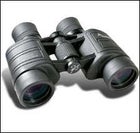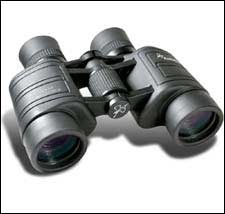Lots of choices out there. But first, a little nomenclature. Binoculars all come with a set of numbers: 7×35, 8×40, 10×60, that sort of thing. There’s other stuff going ondesign, coatings, types of glass usedbut in this price range the most important stats are those pairs of numbers. So, what do they mean? Think of the second number as the diameter of the lenshow wide it is. This affects how much light can go through the lens and hit your eye. A bigger number means a wider lens, letting more light through for a brighter image.
 Intrepid
Intrepid
The first number is the magnification offered: seven power, ten power, and so forth. Here it might seem that a bigger number is also better, and often that’s the case. But not always, for the simple reason that more magnification can also magnify problems such as binocular shake. Generally, a ten-power binocular is thought to be about the highest-power pair of glasses one can handhold with reasonable results. Anything more than that and a tripod might be in order.
With all that in mind, one excellent choice would be the Audubon-brand 10×40 Intrepid binoculars ($160; www.audubonbinoculars.com). They’re powerful, with good brightness for typical daytime viewing. The design is what is called a BaK-4 Porro Prism, which is typical for what you might think of as “standard” full-size binoculars. That said, the Intrepid is a pretty compact set, which is of course good for travel. As a plus they’re rubber-coated and waterproof.
Pentax also makes a good, well-priced set of binoculars, the 10×50 PCF WP II glasses ($179; www.pentaximaging.com). As the numbers indicate, these glasses are the same power as the Audubons, but will also be a touch brighter. They’re also a little bulkier. Nicely designed, with comfortable grips and good eyepieces for use with glasses (if you want to lend to a bespectacled neighbor, say), plus they’re waterproof and rubber-coated.
Lastly, in a more compact “roof prism” design, Bushnell’s 8×42 Excursion glasses ($260; www.bushnell.com) have a nice balance of brightness and power in a pocket-sized design. As a bonus they have a slightly wider angle of view than the Intrepids or Pentax glasses.
Of course, as with most optical products, the listed MSRP can usually be found deeply discounted at retail outlets like Amazon, Wal-Mart, or specialty camera and optics stores. For example, the Excursions can be had for $100 off the list price at Amazon.com, keeping you in your budget. The Pentax and Audubons can be had for $140 and $130, respectively.
If you can, try to get into a shop that carries these three or similar pairs. Try them outyou might find that one has clearly better optics (pun intended), or feels more comfortable in the hand.
For more expert reviews of the world’s best binocs, check out ���ϳԹ��� Online’s all-new .


